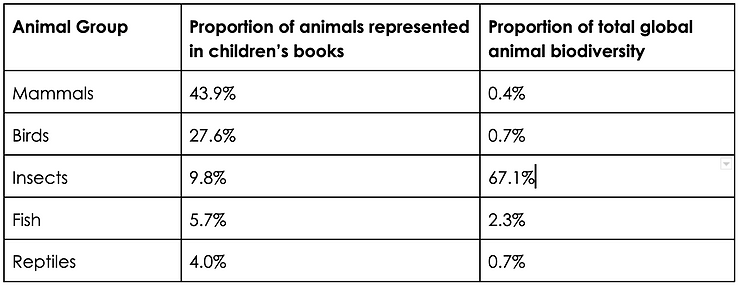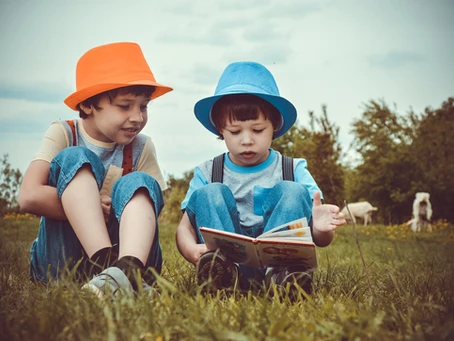Why children’s books need to be about more than just a cat in a hat
By Michael Golden
Title: Animal biodiversity and specificity in children’s picture books
Author(s) and Year: Michiel Jan Dirk Hooykaas, Marloes Gertrudis Holierhoek, Joris Sebastiaan Westerveld, Menno Schilthuizen and Ionica Smeets (2022)
Journal: Public Understanding of Science (open access)
| TL;DR: Picture books are a key source of scientific information for young children. The way in which picture books portray the animal world is one such example. This study analysed the animal diversity depicted in over 200 award-winning children’s picture books. The results show that the books are severely lacking in animal biodiversity, with results heavily skewed towards mammals, in particular domestic and exotic species. Increasing the diversity of animals depicted in children’s picture books, such as including more native species and invertebrate species, can foster deeper connections between children and nature. Why I chose this paper: I decided to write about this paper because I wanted to know more about how science communication occurs amongst younger audiences, as I believe that what we are exposed to at a young age can strongly influence our values as adults. |
Background
If you were asked to picture people engaging in science communication, what kind of people would you envision? More precisely, how old are they? Most likely, you pictured adults, perhaps a scientist talking to a member of the public.
But science communication occurs in a variety of ways, across a variety of mediums, and it happens across all ages. Children might not be a common focus for science communication practitioners, but they are an important demographic to consider. The knowledge and values instilled in our youngest constituents can have positive impacts for generations to come.
Children are presented with scientific information in many ways; their toys, movies, television, and also through picture books – the medium chosen for this study by Hooykaas et al.
The study focussed on the diversity of animals found in picture books. Biodiversity is crucial for the healthy ecosystems that provide us with the food we eat and the air we breathe. Raising public awareness is vital to support conservation efforts, however, a previous study has unfortunately shown a lack of public awareness about animal biodiversity. Starting with kids, and more pertinently kids’ books, could be an important first step in closing this gap. Hence, the authors of this study sought to better understand how diversity of the animal world is portrayed to children in their books.
The Method
A quantitative content analysis was conducted for this study. The authors included all story-based picture books written for children aged 2-9 years that received an award in the Netherlands between 2010 and 2020. This provided a sample size of 217 books.
Representations of animals in the books differed in their specificity (e.g. some may refer to a generic ‘bird’, while others specify the exact species of bird). For this study, each animal was identified to the lowest taxonomic level possible.
The authors also analyzed anthropomorphism – where animals exhibit human-like characteristics – with three types identified: wearing clothes and accessories, human behaviour such as speech and bipedal walk, and human facial features / expressions.
The researchers also noted whether the animals depicted were main, supporting or minor characters in the story, and the animals were also grouped according to two criteria: exotic/native and domestic/non-domestic.
The Results
Across the 217 books analysed, the final data set included 2,237 animals in total (155 main characters, 544 supporting characters and 1,538 minor characters).
Diversity
The overwhelming majority (85.5%) of the animals portrayed represented vertebrates – this is despite the fact that invertebrates account for more than 95% of global biodiversity.
Looking further into different animal groups, Table 1 below shows the top five most featured animal groups represented in the books, shown against the corresponding proportion of global animal biodiversity which that animal group accounts for (source):
Table 1

Other animal groups, such as amphibians, molluscs, arachnids and crustaceans, only accounted for very small proportions of the animals represented in the books.
Domestic animals (dogs, cats, farm animals etc.) had a very high representation – nine of the top ten most featured animal species were domestic. Regarding animal origin, approximately two-thirds (65.6%) were exotic, with only one-third (34.4%) being native animals.
Specificity
Representations of animals in the books were highly generalised – only 39.4% of animals could be identified at the species level, of which the majority were domestic mammals. Mammals could be identified as a distinct species far more commonly than other animals (65.8% vs 18.7%).
Prominence
Mammals were also more prominent in the story – they were by far the animal group that most commonly plays the leading role – with birds, insects and fish more common as minor characters (see Figure 1).

Figure 1

Figure 1 – The proportion of different animal groups that featured in the books, for main, supporting, and minor characters.
Anthropomorphism
Some form of anthropomorphism was seen in the large majority of books (77.4%), and of all the animals encountered, 42.1% were represented anthropomorphically. When looking at the main characters, they were almost always anthropomorphic (96.1%).
Discussion
Educating children about biodiversity is unlikely to be the primary goal of most kids’ picture books, but they nonetheless offer a great opportunity for children to learn about animals and nature.
The results of this study indicate, unfortunately, that there is some way to go before we can say that children’s books provide a truly diverse view of the animal world. The current picture depicted by children’s books is that of a world heavily skewed towards vertebrates – in particular mammals and domestic species – with native animals also being sadly overlooked for more charismatic and exotic counterparts.
This bias towards certain animals leaves many others as vastly underrepresented by comparison, particularly for the headline characters. Insects and fish featured far less than mammals, despite their species richness in the world being far greater. That’s not to say that children’s books need to perfectly match real-world biodiversity – that is not practical and these books have other aims as well. But at least increasing the presence of less charismatic species in picture books, such as insects and other invertebrates, would increase young people’s awareness and appreciation for the great variety of animals in the world, and the important role they all play within healthy ecosystems. The low proportion of native animals is also particularly disheartening, given the opportunity they provide for children to develop a sense of belonging to their local environment.
The lack of specificity provided in the animal depictions (e.g. generic ‘birds’ and/or ‘fish’) would also contribute to a lack of appreciation for true diversity. And the animals that were more highly specified were generally the same ones that already featured prominently (e.g. mammals).
Anthropomorphising animals can also impact how children view animals within the world, blurring the line between what is real and not, and may potentially introduce misconceptions. For example, anthropomorphism may make real animals seem dull by comparison, or children may view any non-human-like animals as simple objects.
The Final Word
What does this research mean for science communicators? Firstly, it is important for them to be champions for biodiversity, and to be cognisant of diversity when representing the animal world to their audiences. They could also use their position to inspire authors and illustrators to feature a wider range of animals in their books, and encourage parents and teachers to select kids’ books that depict a greater amount of animal diversity.
No doubt book writers and publishers are heavily influenced by what animals they believe will be loved by and appeal to their audiences. But clever writing, illustrations and marketing could surely be employed to increase the variety and scope of the ‘loveable creatures’ we see in these books, and overcome traditional assumptions and biases.
We shouldn’t underestimate the power of how our experiences and what we’re exposed to at a young age can impact our values and choices later on in life. If we can show our kids the true wealth of biodiversity in the world, perhaps they will grow up with a deeper connection to our environment and an increased willingness and desire to protect it.
Edited by Niveen AbiGhannam and Teodora Stoica
Cover image credit: Victoria_rt from Pixabay

